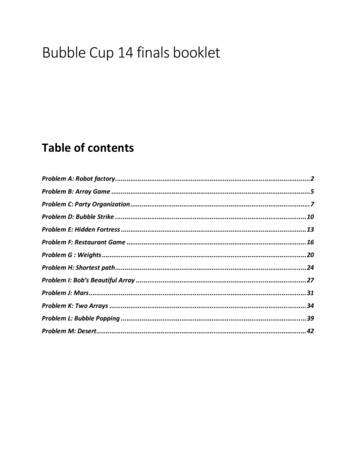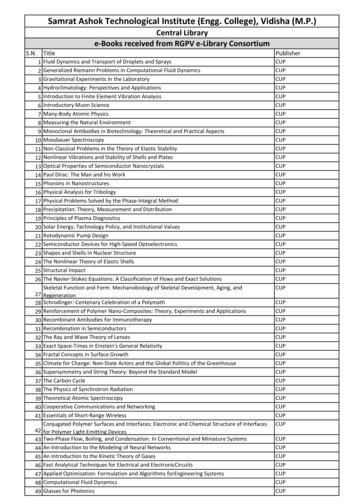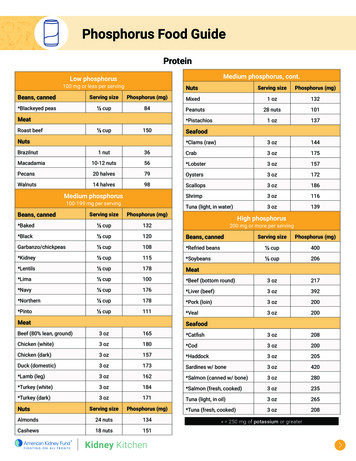
Transcription
Bubble Cup 14 finals bookletTable of contentsProblem A: Robot factory . 2Problem B: Array Game . 5Problem C: Party Organization . 7Problem D: Bubble Strike . 10Problem E: Hidden Fortress . 13Problem F: Restaurant Game . 16Problem G : Weights . 20Problem H: Shortest path . 24Problem I: Bob’s Beautiful Array . 27Problem J: Mars . 31Problem K: Two Arrays . 34Problem L: Bubble Popping . 39Problem M: Desert. 42
Problem A: Robot factoryRising Stars onlyAuthor:Implementation and analysis:Djordje AndjelkovicDjordje AndjelkovicPetar VasiljevicStatement:You have received data from a Bubble bot. You know your task is to make factory facilities, but beforeyou even start, you need to know how big the factory is and how many rooms it has. When you look atthe data you see that you have the dimensions of the construction, which is in rectangle shape: 𝑁 𝑥 𝑀.Then in the next N lines you have M numbers. These numbers represent factory tiles and they can gofrom 0 to 15. Each of these numbers should be looked in its binary form. Because from each number youknow on which side the tile has walls. For example number 10 in its binary form is 1010, which meansthat it has a wall from the North side, it doesn't have a wall from the East, it has a wall on the South sideand it doesn't have a wall on the West side. So it goes North, East, South, West.It is guaranteed that the construction always has walls on its edges. The input will be correct.Your task is to print the size of the rooms from biggest to smallest.Constraints: 1 𝑁, 𝑀 1000Input:The first line has two numbers which are N and M, the size of the construction.Next 𝑁 𝑥 𝑀 numbers represent each tile of constructionOutput:Once you finish processing the data your output consists of one line sorted from biggest to smallestroom sizes.Example input:49553514 11 12 1315 11 6 79 14 9 142 14 3 14Example output:9 4 4 2 1
Explanation:For the input above, this is the look of the construction.North means up. East is right, South is down, and West is 11011000110100100111101011111101110In the layout above we can see that we have one biggest room of 9 tiles, we have one room of 1 tilewhich is number 15 – 1111. On the most right we have one room of 2 tiles: 1101 and 0111, and tworooms of 4 tiles next to it. So, the output is: 9 4 4 2 1 sorted.Time and memory limit: 1s / 256 MB
Solution and analysis:It can be seen that given problem can be represented as graph where nodes are tiles and thereis edge to the neighboring tile if there is no wall between them. Therefore, in order to calculatesize of all of the rooms we have to find all connected components in graph and theircorresponding sizes which can be done with simple DFS or BFS. After that, we have to sort sizeswhich can be done with counting sort so therefore overall complexity would be 𝑂(𝑁𝑀).
Problem B: Array GameRising Stars onlyAuthor:Renea MošoImplementation and analysis:Renea MošoIvan JevtićStatement:Alice and Bob are playing a game. They are given an array A of length N. The array consists ofintegers. They are building a sequence together. In the beginning, the sequence is empty. In oneturn a player can remove a number from the left or right side of the array and append it to thesequence. The rule is that the sequence they are building must be strictly increasing. The winneris the player that makes the last move. Alice is playing first. Given the starting array, under theassumption that they both play optimally, who wins the game?Input:The first line contains one integer N - the length of the array AThe second line contains N integers A1, A2, ,ANOutput:The first and only line of output consists of one string, the name of the winner. If Alice won, print“Alice“, otherwise, print “Bob“.Constraints: 1 𝑁 2 1050 𝐴𝑖 109 , 1 𝑖 𝑁Example input 1:512323Example output 1:AliceExplanation 1:Alice can take the last element from the array. Now Bob cannot make a move, because theremaining options (1 and 2) will not make an increasing sequence.Example input 2:3121Example output 2:BobExplanation 2:Alice can number one from either side. Now Bob takes number 2, and Alice can’t make a move.Time and memory limit: 1s / 256 MB
Solution and analysis:We have two cases: The player that is on the move can take a number from either the left or right end of the array.The player that is on the move can take a number only from one end of the array.Let's first solve Case 2:Since only the number on one end of the array can be taken, the other end of the array is foreverblocked. That means that until the end of the game, the players can only take numbers from one end ofthe array. We can pre-calculate the length of the increasing sequence (to the left and to the right) foreach number and based on the parity of the length of the increasing sequence we can determine whowins the game.Case 1:Let's say that the array is 𝐴, 𝐶, . , 𝐷, 𝐵, and let's say that 𝐴 𝐵. If the player that is on the movetakes B, that means that the left side of the array is now blocked, and then we are left with Case 2. Ifthat happens, we already know the outcome. If the outcome is favourable for the player that is now onthe move, he wins. Otherwise, he should take A, because then he might at least have a chance to win.Now we are left with the array 𝐶, . , 𝐷, 𝐵, which we can recursively solve.Time complexity: 𝑂(𝑛)
Problem C: Party OrganizationRising Stars onlyAuthor:Nikola PešićImplementation and analysis:Nikola PešićRenea MošoStatement:On the great island of Baltia, there live 𝑁 people, numbered from 1 to 𝑁. There are exactly 𝑀 pairs ofpeople that are friends with each other. The people of Baltia want to organize a successful party, butthey have very strict rules on what a party is and when the party is successful. On the island of Baltia, aparty is a gathering of exactly 5 people. The party is successful if either all the people at the party arefriends with each other (so that they can all talk to each other, without having to worry about talking tosomeone they are not friends with) or no two people at the party are friends with each other (so thateveryone can just be on their phones without anyone else bothering them).Please help the people of Baltia organize a successful party or tell them that it's impossible to do so.Input:The first line contains two integer numbers, 𝑁 and 𝑀 – the number of people that live in Baltia, and thenumber of friendships.The next 𝑀 lines each contains two integers 𝑈𝑖 and 𝑉𝑖 – meaning that person 𝑈𝑖 is friends with person𝑉𝑖 . Two friends cannot be in the list of friends twice (no pairs are repeated) and a person can be friendswith themselves (𝑈𝑖 𝑉𝑖 ).Output:If it is possible to organize a successful party, print 5 numbers indicating which 5 people should beinvited to the party.If it is not possible to organize a successful party, print -1 instead.If there are multiple successful parties possible, print any.Constraints: 5 𝑁 2 1050 𝑀 2 1051 𝑈𝑖 , 𝑉𝑖 NExample input 1:6 31 4
4 25 4Example output 1:1 2 3 5 6Example input 2:5123442345Example output 2:-1Time and memory limit: 1s / 256 MB
Solution and analysis:If we have at least 48 people, we will always be able to find a successful party (because it is known thatRamsey's number for (5,5) is between 43 and 48 inclusive). If we have more than 48 people, we can justsearch for a successful party within the first 48 people, ignoring the rest. This means that we can solvethe task with a brute-force algorithm. The complexity of this algorithm is 𝑂(𝑁 5 ).
Problem D: Bubble StrikePremier League and Rising StarsAuthor:Nikola SmiljkovićImplementation and analysis:Nikola SmiljkovićUroš BerićStatement:Little Johnny Bubbles enjoys spending hours in front of his computer playing video games. His favouritegame is Bubble Strike, a fast-paced bubble shooting online game for two players.Each game is set in one of the N maps, each of them having different terrain configurations. First phaseof each game decides on which map the game will be played. The game system randomly selects threemaps and shows them to the players. Each player must pick one of those three maps to be discarded.The game system then randomly selects one of the maps that were not picked by any of the players andstarts the game.Johnny is deeply enthusiastic about the game and wants to spend some time studying maps, thusincreasing chances to win games played on those maps. However, he also needs to do his homework, sohe does not have time to study all the maps. That is why he asked himself the following question: "Whatis the minimum number of maps I have to study, so that the probability to play one of those maps is atleast P"?Can you help Johnny find the answer for this question? You can assume Johnny's opponents do notknow him, and they will randomly pick maps.Input:The first line contains two integers N and P - total number of maps in the game and probability to playmap Johnny has studied.Output:Output contains one integer number - minimum number of maps Johnny must study.Constraints: 3 N 10000 P 1Example input 1:7 1Example output:6
Time and memory limit: 0.5s / 256 MB
Solution and Analysis:Let us determine what is the probability for a map Johnny has studied to be chosen for the next gameout of three randomly selected maps.We know that Johnny smartly discards maps, so he will never discard a map he has studied unless he hasstudied all three of them. Also, the other player does not know which maps Johnny has studied, so hewill not always target them.With three randomly selected maps by the game system there are four cases: Johnny has studiedexactly three, two, one or none of those maps.If Johnny has studied at least two of them, Johnny can discard the map he has not studied (if such exists)and the game will be played on a map he has studied. If he has studied exactly one map of the three,then the probability is 50%, depending on the opponent's choice. Lastly, if he has not studied any of themaps, the probability is 0%.Thus, the formula which determines chances for a map Johnny has studied to be the chosen is:(𝐶3 𝐶2 ) 100% 𝐶1 50% 𝐶0 0%𝑃 𝐶3 𝐶2 𝐶1 𝐶0where 𝐶𝑖 represents the number of ways the system can select three maps out of N and Little JohnnyBubbles has studied exactly i maps out of those three maps.Now, let us determine values 𝐶𝑖 depending on N, the total number of maps, and K, the number of mapsLittle Johnny Bubbles has studied.Since there are 𝐾 maps Johnny has studied and 𝑁 𝐾 maps he has not studied, we have that: 𝐶3 (𝐾3) (𝑁 𝐾), 𝐶2 (𝐾2) (𝑁 𝐾), 𝐶1 (𝐾1) (𝑁 𝐾) and 𝐶0 (𝐾0) (𝑁 𝐾).0123At the end, it is left to find value K. We can try each value for K up to N, and pick the smallest valuewhere probability is larger or equal to the target probability.Additionally, it can be proven that larger K has larger probability so binary search by K can be performedfor more optimal solution. However, considering problem constraints, it is not necessary.
Problem E: Hidden FortressPremier League and Rising StarsAuthor:Implementation and analysis:Nikola PešićNikola PešićRenea MošoAleksandar CvetićStatement:As part of your contribution in the Great Bubble War, you have been tasked with finding the newly builtenemy fortress. The world you live in is a giant 109 x 109 matrix, with coordinates of the matrix squaresnumbered from 1 to 109.You know that the enemy base has the shape of a rectangle, with the sides parallel to the sides of thematrix. The people of your world are extremely scared of being at the edge of the world, so you knowthat the base does not contain any of the squares on the edges of the matrix (the x or y coordinatebeing 1 or 109).To help you locate the base, you have been given a device that you can place in any square of thematrix, and it will tell you the Manhattan distance to the closest square of the base. The Manhattandistance from square (a, b) to square (p, q) is calculated as 𝑎 𝑝 𝑏 𝑞 . If you try to place thedevice inside the enemy base, you will be captured by the enemy. Because of this, you need to makesure to never place the device inside the enemy base.Unfortunately, the device is powered by a battery, and you cannot recharge it. This means that you canuse the device at most 40 times.Input:This problem is interactive.The input contains the answers to your queries.Output:Once you are sure where the enemy base is located, you should print “! x y p q,“ where (x, y) is thesquare inside the enemy base with the smallest x and y coordinates, and (p, q) is the square inside theenemy base with the largest x and y coordinates.Interaction:Your code is allowed to place the device on any square in the matrix by writing “? i j.“ In return, it willreceive the Manhattan distance to the closest square of the enemy base or -1 if the square you placedthe device on is inside the enemy base or outside the matrix.Your solution should use no more than 40 queries.
This is an interactive problem. You must use a flush operation right after printing each line. For example,in C you should use the function fflush(stdout), in Java — System.out.flush(), in Pascal — flush(output)and in Python — sys.stdout.flush().Time and memory limit: 1s / 256 MB
Solution and Analysis:Problem can be solved using just 4 queries. We will use the first two queries to find a point on themiddle of one side of the fortress by querying Manhatton distance for 𝑑1 𝑞𝑢𝑒𝑟𝑦(1, 109 ) and 𝑑2 𝑞𝑢𝑒𝑟𝑦(109 , 109 ) . By getting these two distances we can now calculate 𝑦𝑚 coordinate of middle of oneside of the fortress. 𝑦𝑚 1 109 1 𝑑1 𝑑22Then by querying 𝑑3 𝑞𝑢𝑒𝑟𝑦(109 , 𝑦𝑚 ) we can get distance from one side of the fortress and fromquerying 𝑑4 𝑞𝑢𝑒𝑟𝑦(1, 𝑦𝑚 ) we can get distance from other side.Then we can calculate coordinates of all four corner points of the fortress:𝑥 1 𝑑4𝑦 1 𝑑2 𝑑3 𝑝 109 𝑑3𝑞 109 𝑑1 𝑑3
Problem F: Restaurant GamePremier League and Rising StarsAuthor:Aleksandar DamjanovićImplementation and analysis:Aleksandar DamjanovićUroš BerićStatement:Alice and Bob always had hard time choosing restaurant for the dinner. Previously they performed EenieMeenie Miney Mo game, but eventually as their restaurant list grew, they had to create a new game.This new game starts as they write restaurant names on 𝑁 cards and align the cards in one line. Beforethe game begins, they both choose starting card and starting direction they are going to. They take turnsin order one after another. After each turn, they move one card in their current direction. If they reachthe end or beginning of the line of cards they change direction. Once they meet in a card, the card ismarked for removal and is removed the first moment they both leave the card.
They repeat this process until there is only one restaurant card left. Since there are a lot of restaurantcards, they are bored to simulate this process over and over and need your help to determine the lastcard that remains. Can you help them?Input:The first line of the input is one integer 𝑇 representing number of test cases.Each test case contains 3 lines:The first line contains an integer 𝑁 representing initial number of cards.Next line contains two integer values 𝐴, 𝐵 representing starting 0-based index of the card in the array.Last line contains two strings 𝐷𝐴 , 𝐷𝐵 representing starting direction of their movement. Direction isrepresented with lower case English letters and can either be “left” or “right”.Output:The output contains 𝑇 integer number – the 0-based index of the last card that remains for every testcase in order.Constraints: 1 𝑇 1042 𝑁 10180 𝐴, 𝐵 𝑁𝐴 𝐵𝐷𝐴 , 𝐷𝐵 {𝑙𝑒𝑓𝑡, 𝑟𝑖𝑔ℎ𝑡}Example input:140 1left rightExample output:0Explanation:Note that since Alice is starting at the beginning of the line even though her initial direction is left, onher next move she will go right.Time and memory limit: 1s / 128 MB
Solution and analysis:Firstly, let's narrow down possibilities for the solution by proving the following statement:The last node that remains is either node with index 𝟎 or node with index 𝑁 1.Let's assume that node 0 is about to be removed. We are then in a situation as following:ABOO.OO, where 𝑨 is Alice standing on node 0, 𝑩 is Bob standing on one node to the right, O are therest of the nodes and it's the Bobs move to go left. After that they both will be moving in the rightdirection removing nodes one by one until the far-right node. Same applies when node 𝑵 𝟏 is aboutto be removed. We conclude that when a node at the very end of the list needs to be deleted, allnodes are deleted all the way to the opposite end.So, if node 0 is deleted before node 𝑵 𝟏, node 𝑵 𝟏 is the last to stand and vice versa.Thus, the solution is either node 0 or node 𝑁 1.Let's go to the situation in which directions of Alice and Bob are equal. If initial directions are opposite,then we need to calculate which player will come to the edge first where he will change the direction.Let's assume their initial directions are opposite. If Alice is left to Bob and he moves to the right, itmeans that the two players will meet at some point, so one node will get deleted in the process.Afterwards, once we determine which player will come to the edge first and the number of moves ittakes him to do that, we will then calculate their new positions and distance between them, also payingattention if they have met in which case, we will just decrease the distance by one.Now, they are moving in the same direction. Note that when the players meet and a node gets deleted,the next time they have the same direction the distance between them will be less than before. Everytime after (or before, if you wish) they meet there will be a situation in which they have the samedirection, because they move alternately one player will always come to the edge first and change hisdirection. That means the distance between them decreases by one every time they meet, and inbetween their meetups the direction changes, alternately. When we find the first position in which theyhave the same direction, we can determine after how many meetups and changes of the direction willthere be no nodes between them (the distance will become 0) and they will be deleting nodes one byone in the direction they are moving.We have found the position in which they have the same direction and the distance between them.They moved the same number of steps after their initial position, so the next to move is Alice.Let us say we are in the following situation:.B000A. and they both move left. The distance between them is 4 and they move left, after nextmeetup it will be 3 and the direction will be right etc. At the end the distance between them will be 1(.AB.) and they will be moving right. Here the players will just start removing nodes one by one to thefar right, thus the last one standing will be node 0. (Note that they can't remove node 0 before node n-1this way because Alice is left to Bob and he moves right first).Let's see the following situation:
.B000A. and they both move right. The distance between them is 4 and they move right, after thenext meetup, it will be 3 and the direction will move left etc. At the end the distance between them willbe 1 (.AB.) and they will be moving left. In this situation they still will not be removing nodes one byone because Alice is moving away from Bob, so they will need one more meetup. So, when at the startAlice is moving away from Bob, they need one more meetup to start removing nodes one by one.Knowing this, their positions in which they have the same direction for the first time thus the distancebetween them and the direction they are moving to, we can determine what node will be the last onestanding. If at the beginning Alice moves away from Bob, we can just increase the initial distance by 1. Ifthe initial distance is divisible by 2, by the time it becomes 1 they will be moving in the oppositedirection.If the initial distance is 4, they are moving left and Alice is not moving away from Bob, when the distancebecomes 1, they will be moving right and thus the last node standing will be node 0 (like in the firstexample above). If the initial distance is 4, they are moving right and Alice is moving away from Bob, wecan just say that the initial distance between them is 5. When the distance becomes 1, they will bemoving right, so also in this case node 0 is the last one to stand (like in the second example above).
Problem G : WeightsPremier League and Rising StarsAuthor:Pavle JanevskiImplementation and analysis:Pavle JanevskiIvan JevtićStatement:You are given an array A of length N weights of masses A1, A2 AN. No two weights have thesame mass. You can put every weight on one side of the balance (left or right). You don't haveto put weights in order A1, ,AN. There is also a string S consisting of characters ‘L’ and‘R’, meaning that after putting the ith weight (not Ai, but ith weight of your choice) the left orright side of the balance should be heavier. Find the order of putting the weights on the balancesuch that rules of string S are satisfied.Input:The first line contains one integer N - the number of weightsThe second line contains n distinct integers A1, A2, ,AN - weights givenThe third line contains string S of length N consisting only of letters 'L' and 'R' - stringdetermining which side of the balance should be heavier after putting the ith weight of yourchoiceOutput:The output contains N lines. In every line, you should print one integer and one letter - integerrepresenting the weight you are putting on the balance in that move and the letter representingthe side of the balance where you are putting the weight. If there is no solution, print -1.Constraints: 1 𝑁 2 1051 𝐴𝑖 109 , 1 𝑖 𝑁Example input 1:53 8 2 13 7LLRLLExample output 1:3L2R8R13 L7LExplanation 1:Explanation for the test case:
after the 1st weight: 3 L (left side is heavier)after the 2nd weight: 2 R (left side is heavier)after the 3rd weight: 8 R (right side is heavier)after the 4th weight: 13 L (left side is heavier)after the 5th weight: 7 L (left side is heavier)So, the rules given by string S are fulfilled and the order of putting the weights is correct. Time and memory limit: 1s / 256 MB
Solution and analysis:First, we sort the weights. Now there is one key observation in order to solve this task. If we lookat a sorted subarray A[L:R] (1 𝑙 𝑟 𝑁), such that weights are distributed alternately (AL onone side, AL 1 on opposite side ), heavier side of the balance will always be the one where weput the last weight, the heaviest one.Proof: There are 2 options:Option 1:We have distributed equal number of weights on both sides and now on side 1 we have:AL, AL 2, ., AL 2*K and on side 2 we have:AL 1, AL 3, . AL 2*K 1.On the side 2, every weight is heavier than the corresponding weight on the other side.AL 1 AL, AL 3 AL 2, . AL 2*K 1 AL 2*K 1 AL 2*i 1 AL 2*i, 0 𝑖 𝐾.It is easy to see why is side 2 heavier than side 1. So, the side that we put the last weight on isthe heavier side.Option 2:We have put the last weight on side 2, and now we have AL, AL 2, ., AL 2*K on that side, andAL 1, AL 3, . AL 2*K-1 on side 1. If we eliminate AL on side 2, we have the same number ofweights on both sides. The pairs are:AL 1 - AL 2, AL 3 - AL 4, . AL 2*K-1 - AL 2*K. From these pairs, we see that all the heavier weightsfrom pairs belong to side 2. On top of that if we add the remainingweight AL00, we can see the side that we put the last weight on is heavier.Now after we have sorted the weights, we are going to find the number of switches from oneletter to another in string S. So, one switch happens when we go from L to R or vice versa(example: RLR has 2 switches). Let’s call the number of switches X. The first weight we are goingto put on the balance, on the side represented with the first letter, is going to be the one onposition N - X in the sorted array. Now we keep two pointers, let’s call them left and rightpointer, and both of them are at the (N – X)th position at the beginning. We go through thestring S, starting from the 2nd letter (because we have already put the first weight), and we havetwo cases. When we do not switch from one letter to another, we decrease the left pointer andput the weight on which the left pointer now points. The side we are putting the weight isopposite from the side we put the weight where the left pointer was previously pointing. We aredoing the similar thing when we make the switch, the difference is just that we increase the rightpointer and put it on the side different from the side we put the previous element the rightpointer was pointing at.Why does this work? We put the first weight on the side represented by the first letter of thestring. Every time we make a switch, we move the right pointer and put it on the opposite side,that side is going to be exactly the side that should be heavier because we only move it whenwe make a switch, so X times in total. When we don’t make a switch, we move the left pointer,and the balance doesn’t change.
Note: It is always possible to find the answer, if you follow the algorithm above
Problem H: Shortest pathPremier League and Rising StarsAuthor:Ivan JevtićImplementation and analysis:Ivan JevtićPetar VasiljevićStatement:You are given N points on an infinite plane with Cartesian coordinate system on it. N-1 points layon one line, and one point isn't on that line. You are on point K at the start, and the goal is to visitevery point. You can move between any two points in a straight line, and you can revisit points.What is the minimum length of the path?Input:The first line contains two integers: N - the number of points, and K - the number of thestarting point.Each of the next N lines contain two integers, Ai and Bi – coordinates of the ith point.Output:The output contains one number – the shortest path to visit all given points starting from pointK. The absolute difference between your output and the solution shouldn’t exceed 10-6.Constraints: 3 𝑁 2 105 106 𝐴𝑖 , 𝐵𝑖 106 , 1 𝑖 𝑁Example input 1:5 20 0-1 12 -20 1-2 2Example output 1:7.478709Explanation 1:The shortest path consists of these moves:2 - 55- 44 - 11 - 3There isn't any shorter path possible.
Time and memory limit: 1s / 256 MBSolution and Analysis:First, let us sort points by 𝑥 coordinate. This way we can enumerate points in some order.Besides that, we also must find a point that is not on the given line. We can solve this with someeasy math. One of the solutions is to take first 4 points from sorted order and calculate values ofslopes between 1𝑠𝑡 point (by order) and other 3. If there is a value that differs from the other 2,then that point is outside the line. Otherwise, just keep iterating over points and find the onesuch that a slope is different than the ones calculated before.Now, let us enumerate points on the same line from 1 to 𝑁 1 and the point outside the line as𝑁. Also, let’s say that we have some indicators of leftmost and rightmost unvisited points, 𝐿 and𝑅. In our case, at the beginning, 𝐿 1 and 𝑅 𝑁 1.Observation: We are never going to alternate moves between two points such that none ofthem is one of 𝐿 or 𝑅. This way we would never “shrink” our range so pathing would not becomeoptimal. Therefore, optimal strategy is to reach 𝐿 or 𝑅 as soon as possible.So, let us fix some point 𝑖 such that 𝐾 𝑖 𝑅 and say that in two passes we reach both 𝐿and 𝑖. There are two possibilities, one is to do movement 𝐾 𝑖 𝐿 and the other one is 𝐾 𝐿 𝑖. In both cases, next move is to reach point 𝑁 that is not part of the line and then comeback to point 𝑖 1. After that we should just go from 𝑖 1 to 𝑅. Therefore, solution for such 𝑖 is:
𝑚𝑖𝑛 (𝑑𝑖𝑠𝑡(𝐾, 𝑖) 𝑑𝑖𝑠𝑡(𝑖, 1) 𝑑𝑖𝑠𝑡(1, 𝑁) 𝑑𝑖𝑠𝑡(𝑁, 𝑖 1) 𝑑𝑖𝑠𝑡(𝑖 1, 𝑁 1) ,)𝑑𝑖𝑠𝑡(𝐾, 1) 𝑑𝑖𝑠𝑡(1, 𝑖) 𝑑𝑖𝑠𝑡(𝑖, 𝑁) 𝑑𝑖𝑠𝑡(𝑁, 𝑖 1) 𝑑𝑖𝑠𝑡(𝑖 1, 𝑁 1)Similar thing can be calculated in case that we pick such 𝑖 where 𝐿 𝑖 𝐾. In this case thesolution is:𝑑𝑖𝑠𝑡(𝐾, 𝑖) 𝑑𝑖𝑠𝑡(𝑖, 𝑁 1) 𝑑𝑖𝑠𝑡(𝑁 1, 𝑁) 𝑑𝑖𝑠𝑡(𝑁, 𝑖 1) 𝑑𝑖𝑠𝑡(𝑖 1,1) ,𝑚𝑖𝑛 ()𝑑𝑖𝑠𝑡(𝐾, 𝑁 1) 𝑑𝑖𝑠𝑡(𝑁 1, 𝑖) 𝑑𝑖𝑠𝑡(𝑖, 𝑁) 𝑑𝑖𝑠𝑡(𝑁, 𝑖 1) 𝑑𝑖𝑠𝑡(𝑖 1,1)We can use the same formula for cases 𝑖 𝐿 and 𝑖 𝑅 but we must be careful of points 𝑖 1 or𝑖 1 that don’t exist in one of these formulas (just count it as a distance equal to 0).One edge case is if starting point is the one outside of the line. Solution for this case is simply:𝑑𝑖𝑠𝑡(1, 𝑁 1) min(𝑑𝑖𝑠𝑡(1, 𝑁), 𝑑𝑖𝑠𝑡(𝑁 1, 𝑁))Ov
North means up. East is right, South is down, and West is left. 1001 1110 1011 1100 1101 0101 1111 1011 0110 0111 0101 1001 1110 1001 1110 0011 0010 1110 0011 1110 . game is Bubble Strike, a fast-paced bubble shooting online game for two players. Each game is set in one of the N maps, each of them having different terrain configurations .










